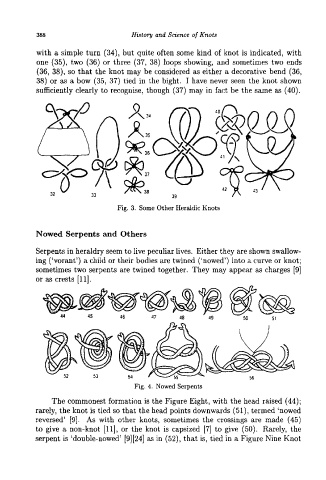Page 394 - J. C. Turner - History and Science of Knots
P. 394
388 History and Science of Knots
with a simple turn (34), but quite often some kind of knot is indicated, with
one (35), two (36) or three (37, 38) loops showing, and sometimes two ends
(36, 38), so that the knot may be considered as either a decorative bend (36,
38) or as a bow (35, 37) tied in the bight. I have never seen the knot shown
sufficiently clearly to recognise, though (37) may in fact be the same as (40).
Fig. 3. Some Other Heraldic Knots
Nowed Serpents and Others
Serpents in heraldry seem to live peculiar lives. Either they are shown swallow-
ing ('vorant') a child or their bodies are twined ('nowed') into a curve or knot;
sometimes two serpents are twined together. They may appear as charges [9]
or as crests [11].
52 53 54 r ^^55 56
Fig. 4. Nowed Serpents
The commonest formation is the Figure Eight, with the head raised (44);
rarely, the knot is tied so that the head points downwards (51), termed `vowed
reversed' [9]. As with other knots, sometimes the crossings are made (45)
to give a non-knot [11], or the knot is capsized [7] to give (50). Rarely, the
serpent is `double-nowed' [9] [24] as in (52), that is, tied in a Figure Nine Knot

